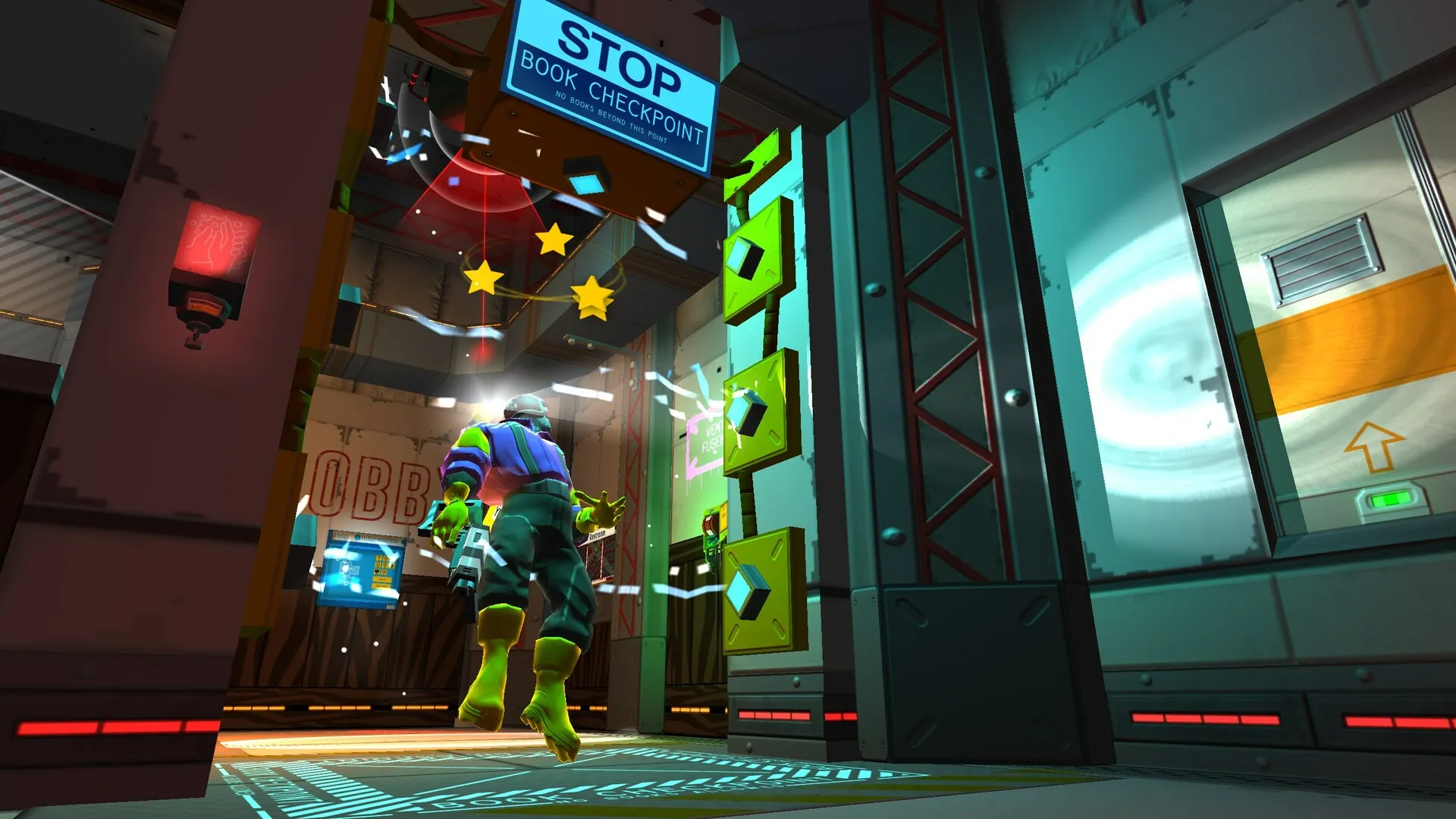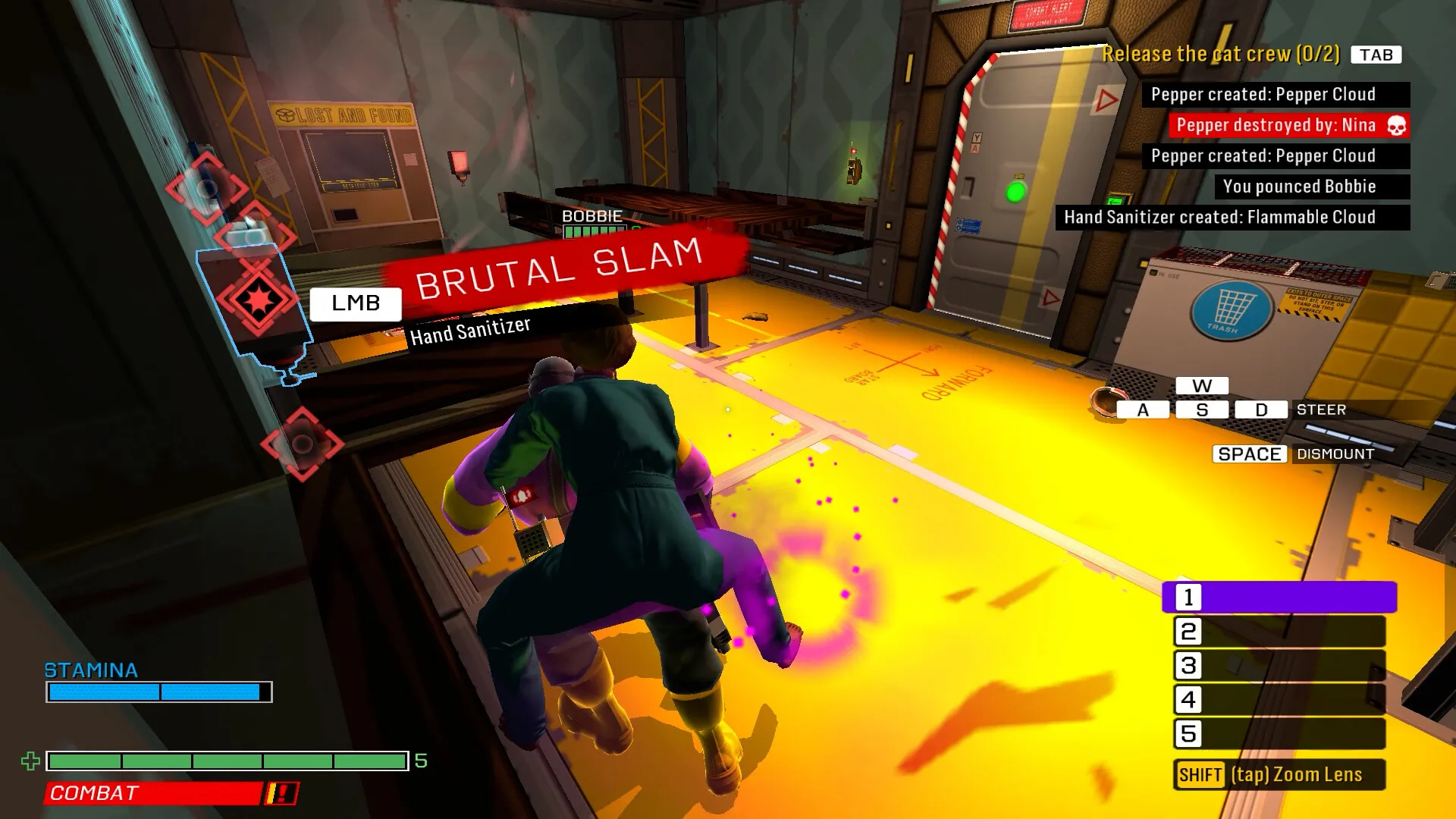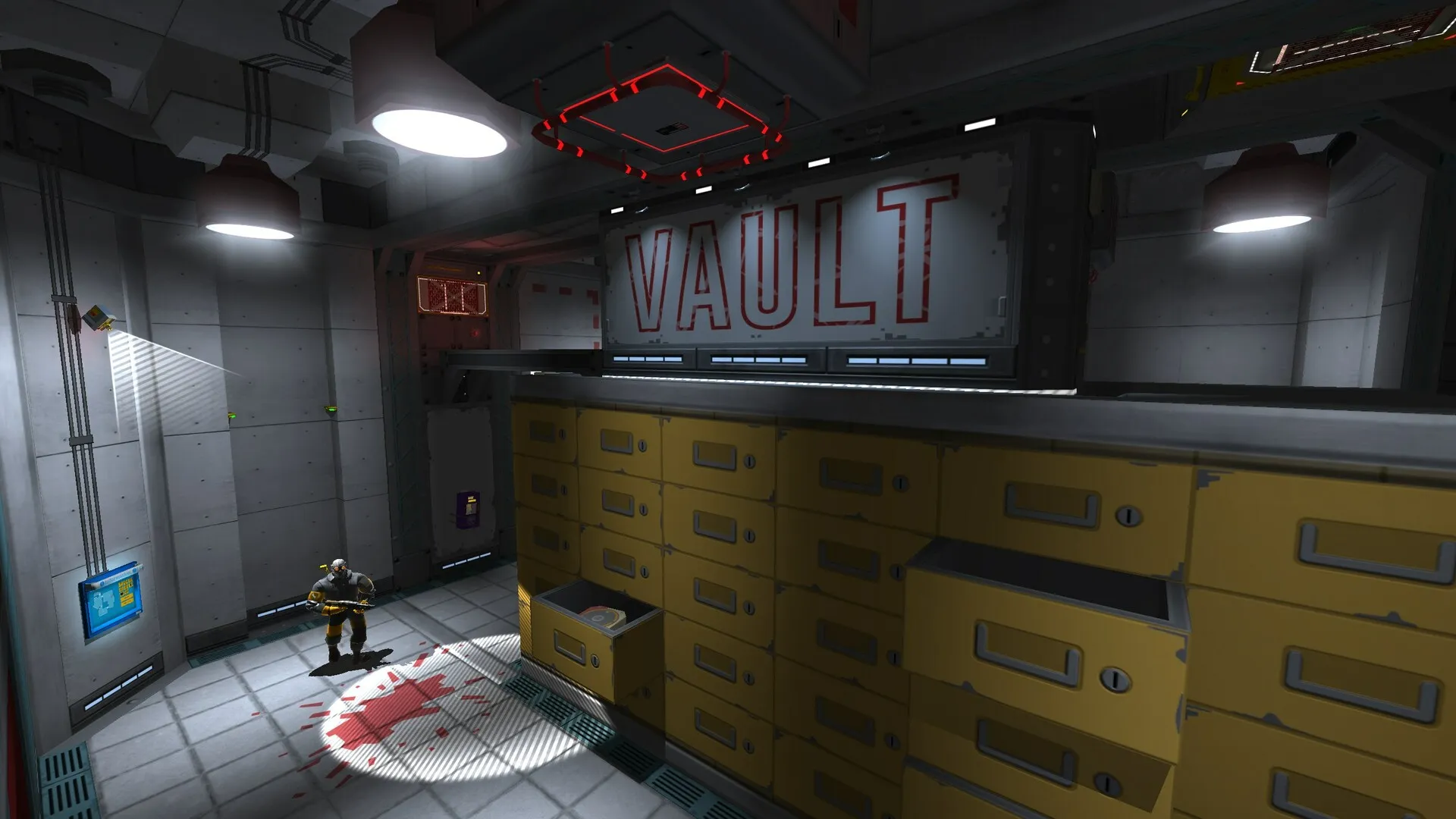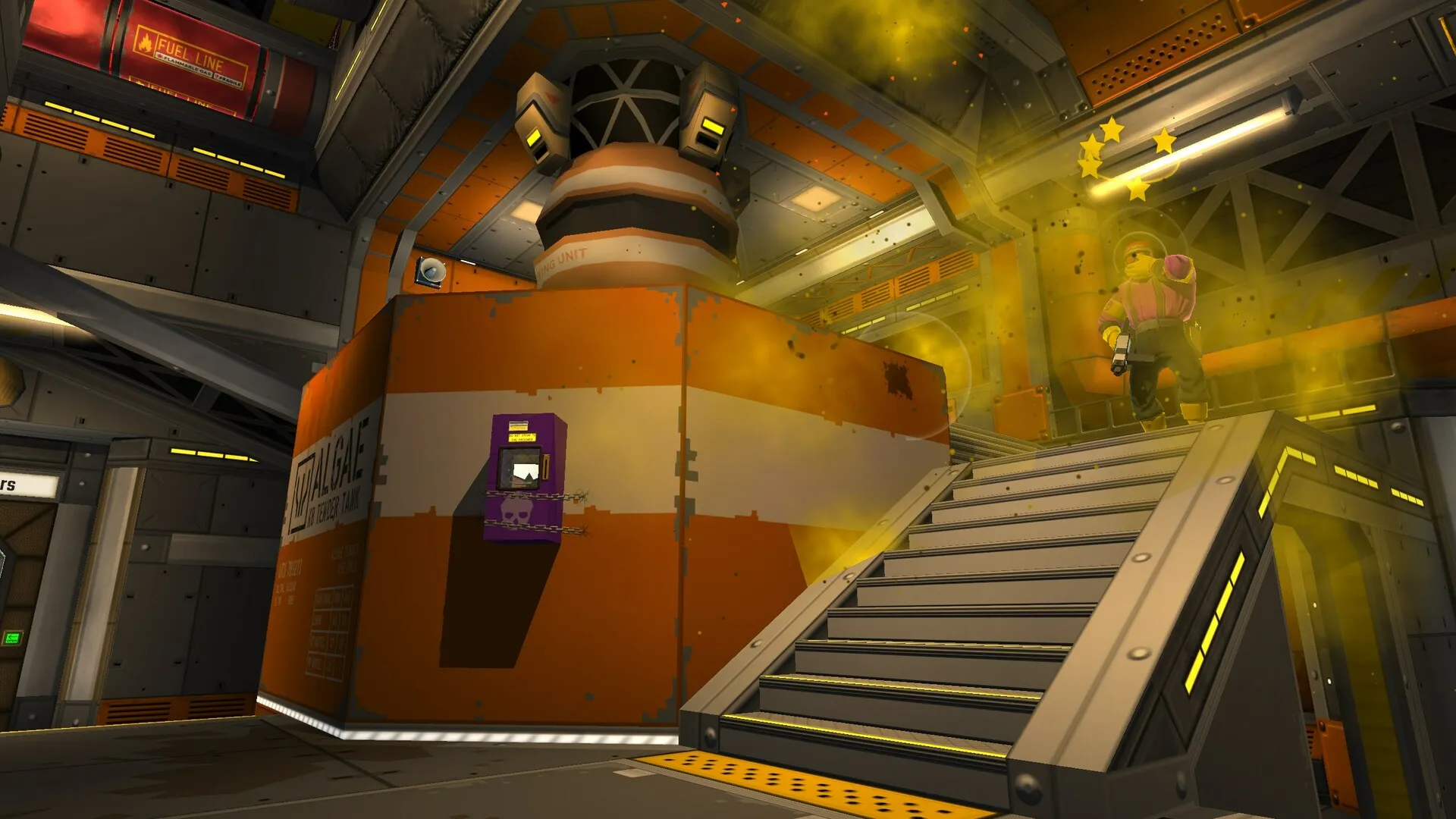Nina Pasadena wakes from cryogenic slumber to find herself strapped into the role of an Insurance Commando—charged with rescuing feline crews trapped aboard pirate-infested starships. Rather than handing her a blaster at the outset, Skin Deep hands her nothing but empty pockets and everyday objects, trusting players to improvise mayhem from mundane items.
At first glance, it feels like a classic immersive sim: crack vents, suss patrol patterns, and swipe keycards. Yet the game’s heart lies in turning a succulent into a sneeze bomb or rigging aerosol cans into floating fire clouds. Its Zoom Lens reveals handwritten notes and labels from across the room, transforming environmental storytelling into a playful treasure hunt that guides without heavy-handed tutorials.
The tone shifts between Bond-style cool and slapstick delight, thanks to retro-futuristic set pieces—libraries rigged with zap gates, floating diners, and observatories where you can take the helm of a telescope. Everything reacts: slice a window, and physics launch objects (and sometimes you) into zero-G ballet.
By making every prop a potential tool or trap, Skin Deep sparks those “aha” moments familiar from classics like Prey or Deus Ex, but filtered through pure, chaotic comedy. It stakes its claim by celebrating ingenious problem-solving and unexpected disasters in equal measure—guaranteeing that no two rescues feel alike.
When Objects Speak: The Mechanics of Mischief
Few moments in immersive sims deliver the rush of discovering that a simple banana peel can rewrite the entire script of a mission. Skin Deep builds its foundation on open-ended levels where vent shafts, trash chutes, and breakable windows offer countless paths to the same goal—rescuing chained cats.
Unlike rigid stealth games that funnel you through guard patterns, here each corridor feels alive, ready to be manipulated. Guards spot you with believable accuracy, yet bumble into traps with goofy timing: a near-miss sneak might trigger a cluster of pepper boxes, sending them into a sneezing frenzy that feels equal parts tense and absurd.
What truly sets Skin Deep apart is its improvised toolkit. Every prop hides a story: soap bars double as stun grenades, aerosol cans can fashion drifting firestorms, and those banana peels? They’re comedic landmines. The Zoom Lens replaces tedious tutorials with playful discovery—read handwritten ship logs or labels from across a room, then tuck away those clues in your Memory Palace. It’s a design choice reminiscent of Deus Ex’s emphasis on environmental storytelling, but delivered with a wink rather than a lecture.
Beneath these tools lies a living simulation that revels in chain reactions. An event log chronicles each twist—when a key flies out a shattered window, drifts in zero gravity, and slams a window seal shut, locking you out and reshaping your escape plan. Fluid dynamics, glass shards, and physics-driven trajectories transform every action into a branching narrative, making you grin as cause-and-effect spirals into comedic mayhem.
Allies to this sandbox are Nina’s own quirks: a sneeze meter that punishes overuse of dusty vents, a finger-snap lure that feels like a silent conversation with nearby pirates, and an “alert” yell that reminds you how tiny you look crouched under a console. These limits and gestures ground the madness, turning each successful escape into a small emotional victory—and leaving you eager to discover what clever disaster awaits next
Levels That Speak: The Art of Ship Layouts
Each mission in Skin Deep feels like stepping into a new chapter of a sci-fi anthology. Take the drifting library level: electrified gates demand you check out enough heavy tomes before they’ll grant access to a waiting shotgun. It turns a familiar trope—the locked door requiring a button press—into a playful riff on academic bureaucracy, where every borrowed book inches you closer to firepower.
Then there’s the floating diner, complete with order trays that double as makeshift raider distractions, or the deep-sea observatory, whose telescope offers both narrative interludes and hidden clues—reminding me of Prey’s knack for scattering story beats across its world.
Vertical movement becomes a storytelling device in itself. Smashable windows fling you into zero-G spaces where you can shimmy along hull panels to bypass crowded halls. Trash chutes send you tumbling into maintenance shafts, while a built-in vacuum resistance system lets you traverse external corridors like an astronaut on a cosmic tightrope. These moments echo the freerunner thrills of Mirror’s Edge, yet grounded in tactile physics: a miscalculated leap can send you sliding into an unexpected firefight, blending suspense and surprise.
Progress through each ship hinges on classic access puzzles: color-coded gates, biometric terminals, and keycards lifted straight from distracted pirates. Snatching a PDA off a guard’s hip might reveal three different codes—one opens a weapons cache, another triggers a mech in the cargo bay, and a third unlocks a secret cassette tape hidden in an office. These secondary tasks reward curiosity, breaking the monotony of “find the key, hit the exit.”
For players who crave more, lateral thinking uncovers optional chambers—dual-button doors requiring you to engineer remote activations, or vantage points that reveal easter eggs in the ship’s story. And because Blendo Games provides full mod support, these stages can evolve with community creativity, ensuring the sandbox never truly runs dry. As you learn each ship’s quirks and hidden pathways, you start to wonder: what new surprises await in a map crafted by another player’s imagination?
Whiskered Allies and Zero-G Showdowns
Nina Pasadena isn’t your typical cold-sleep operative. Once a rogue with a questionable past, she’s thawed into the role of an Insurance Commando, tasked with freeing feline crews from pirate clutches. Her terse quips—sometimes delivered over crackling comms, sometimes inscribed on environmental props—reveal a wry confidence that softens the tension of creaking vents and hissing airlocks. In-mission cutscenes and scattered logs sketch her journey without heavy exposition, letting you piece together her motivations as you rescue one cat chef or space rancher after another.
The cats themselves shape the emotional stakes. Chef Tornado’s frantic “thank you” emails, scuba diver Casiano’s waterlogged anecdotes, and Dusty’s prairie-daydream postcards turn each mission into a personal favor. Those messages aren’t idle fluff—they hint at hidden terminals or offbeat shortcuts, blending warmth with utility. You grow attached not just to the goal of escape pods, but to the quirky personalities waiting at journey’s end.
Opposing Nina is the Numb Bunch, a pirate troupe whose heads pop free and regenerate unless you ship them off into the void. That inventory dilemma—carry vital tools or lug a squawking head?—underscores the tension between compassion and cold calculation. As engineers lay mines and armored elites patrol wider routes, each new enemy type forces you to adapt your rescue tactics, reinforcing the narrative of an evolving, cunning adversary.
Missions unfold in three acts: cat retrieval, rendezvous with the pod, and optional skirmishes that let you decide how messy your finale becomes. Underneath the slapstick chaos, a mystery simmers—why does this pirate gang hunt insurance commandos? Blendo Games sprinkles hints throughout ship logs and side emails, weaving a thematic thread of absurdist duty that invites you to wonder: what deeper motive lies behind the next docking bay?
Retro Radiance and Rhythmic Riffs
Blendo Games leans into id Tech 4’s reliability to craft a world that feels both familiar and slightly weathered. Textures carry the grainy charm of early aughts engines, lending weight to polished chrome hallways and flickering neon signage.
Lighting often catches on the edges of rusted vents or glinted shards of broken glass, hinting at the ages-old sci-fi thrillers that inspired its aesthetic. When you burst through a window into zero-G, the contrast between that dated engine sheen and the vastness beyond creates an almost cinematic tableau—one that nods to 2001: A Space Odyssey while retaining its indie grit.
The soundtrack swings between jaunty sea-shanty electronica when pirate reinforcements arrive, a sly Pink Panther–style jazz during stakeout sequences, and a full-blown Bond-intro flourish for title drops. Ambient cues—dust particles stirring in vents, the squeal of a banana peel underfoot, crackling radio chatter—aren’t mere background noise. They punctuate each stealth approach or sudden skirmish, tapping into your anticipation before a guard even spins around.
UI elements strike a careful balance between utility and immersion. The Zoom Lens “enhance!” overlay feels like a director’s cut: it highlights clues without flooding the screen with text. The Memory Palace tab offers instant recall of overheard codes, and an event log lays out causal breadcrumbs after chaotic moments. Manual saves at terminals grant control, but the sparse autosaves can jar momentum—reminding you that, even in space, timing remains everything.
Replay Value and Rising Stakes
From the first rescue mission to the final hull tear, Skin Deep introduces eight levels that layer new gadgets and hazards at a steady clip. Early stages teach banana-peel traps and the Zoom Lens; by level five, you’re juggling sticky grenades alongside keycard puzzles. Optional side tasks—hunting hidden cassette tapes or repairing a mech in a cargo hold—reward players who explore every nook and offer fresh tools for later runs.
Players choose stealth or all-out brawls. Sneaking past a lone pirate can feel like an intimate dance, whereas luring reinforcements into a flammable cloud carries its own thrill. Deciding whether to carry liberated pirate heads or extra pepper boxes forces constant risk assessments. A full inventory of heads can block your best traps, yet each head flushed into space feeds your toolbox of chaos. That tension between compassion and mischief gives each playthrough its own emotional rhythm.
A New Game+ option ramps up guard alertness and introduces timer-based challenges for seasoned players. The included mod kit transforms missions at the click of a button. Fans can craft fresh maps or tweak AI behavior, ensuring community ideas surface alongside the developer’s. Compared with Dishonored’s level editors, Skin Deep’s tools feel equally accessible yet potent in shaping emergent stories.
For those seeking fresh tests, speedruns pose the ultimate gauntlet—can you clear level three without firing a shot? Or try a “headless” run, where no pirate cranium makes it into your pack. Each challenge highlights a different facet of the sandbox, making you appreciate how a single banana peel can spark an unforgettable chain reaction.
When the Ship Shudders: Performance & Convenience
Blendo Games leans on id Tech 4’s tried-and-true backbone, which delivers solid frame rates even in the most cluttered cargo holds. Still, I hit two crashes during save operations, sending me back to the last manual checkpoint. With levels averaging 20–30 minutes, having to replay large swaths can sting—especially when a thrilling zero-G escape suddenly hiccups.
Terminals allow manual saves at any point, granting agency over progress. However, autosaves occur only at mission starts, leaving long stretches without a safety net. A denser checkpoint grid—perhaps after every major puzzle or cat rescue—would keep momentum without diluting tension.
Control schemes feel natural on both keyboard and controller. Emotes, Zoom Lens toggles, and quick-item slots map cleanly to shoulder buttons or number keys. I found no glaring gaps in remapping options, though an assist mode (slower enemy reaction or unlimited saves) could welcome newcomers to the chaotic sandbox.
The developer’s patch roadmap promises fixes for crash bugs and tweaks to save logic in the weeks ahead. Early community hotfixes have already addressed minor UI hiccups, reflecting a collaborative spirit between players and makers. With these updates on the horizon, one can’t help but wonder how many rough edges will smooth away—revealing even more of the game’s hidden charm.
The Review
Skin Deep
Skin Deep delivers a joyful, unpredictable sandbox where every object sings with possibility. Its clever puzzles, emotional cat rescues, and whimsical tone outweigh the occasional technical hiccup. Fans of immersive sims and newcomers alike will find a memorable adventure ripe for speedruns and mods.
PROS
- Deep item interactivity that fuels creative problem-solving
- Emergent physics chains yield hilarious “happy disasters”
- Memorable cat rescues and charming email vignettes
- Retro-futuristic visuals and dynamic soundtrack
- Intuitive Zoom Lens and Memory Palace tools
- Full mod support for community-driven content
CONS
- Occasional save-related crashes and long replays
- Sparse autosaves can interrupt pacing
- Elite enemies sometimes feel overly punishing
- id Tech 4 visuals show their age in spots





















































